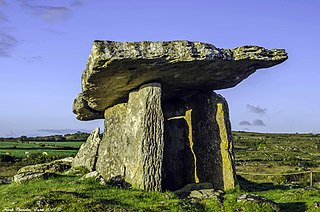
A dolmen or portal tomb is a type of single-chamber megalithic tomb, usually consisting of two or more upright megaliths supporting a large flat horizontal capstone or "table". Most date from the Late Neolithic period and were sometimes covered with earth or smaller stones to form a tumulus. Small pad-stones may be wedged between the cap and supporting stones to achieve a level appearance. In many instances, the covering has eroded away, leaving only the stone "skeleton".

Menorca or Minorca is one of the Balearic Islands located in the Mediterranean Sea belonging to Spain. Its name derives from its size, contrasting it with nearby Mallorca. Its capital is Mahón, situated on the island's eastern end, although Menorca is not a province and forms a political union with the other islands in the archipelago. Ciutadella and Mahon are the main ports and largest towns. The port of Mahon is the second biggest natural port in the world.

A megalith is a large stone that has been used to construct a prehistoric structure or monument, either alone or together with other stones. There are over 35,000 in Europe alone, located widely from Sweden to the Mediterranean sea.
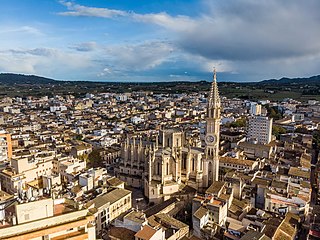
Manacor is a town and municipality on the island of Mallorca, part of the Spanish autonomous community of the Balearic Islands. It is the second largest town in Mallorca, after the capital of Palma. The municipality has tourist areas such as Porto Cristo, site of the famous Caves of Drach, and Cales de Mallorca. Manacor has one of the busiest street markets on the island, held every Monday morning. Manacor is famous for high-quality wood furniture manufacture and artificial pearls.

A talaiot, or talayot, is a Bronze Age megalith found on the islands of Menorca and Majorca forming part of the Talaiotic Culture or Talaiotic Period. Talaiots date back to the late second millennium and early first millennium BC. There are at least 274 of them, in, near, or related to Talaiotic settlements and the Talaiotic chamber tombs known as navetas. Talaiots pre-date the megalithic structures known as taulas, which are usually found nearby. While some Talaiots are thought to have had a defensive purpose, the use of others is not clearly understood. Some believe them to have served the purpose of lookout or signalling towers, as on Menorca, where they form a network. Talaiots generally take the form of circular or square buildings, and they may have been used as dwellings or meeting places. The talayots on Menorca have been much less prone to weathering than the ones found on Majorca. Despite this, very few grave goods have been found in Menorcan talayots, leading historians to believe that the island had a poorer economy than its larger neighbor.


Ses Païsses is a Bronze Age talayotic settlement on the southeastern outskirts of Artà in northeastern Majorca. It is one of the most important and best-preserved prehistoric sites in the Balearic Islands, although it is largely overgrown with woodland, mainly Quercus ilex, making it impossible to see the site as a whole.

Torre d'en Galmés is a Talayotic site on the island of Menorca, between Alaior and Son Bou, Menorca. The town developed from the start of the Talayotic era and expanded until the end of the Roman occupation, after which it was abandoned. Buildings were reoccupied and adapted by Muslim refugees from the Reconquista until the end of the Muslim occupation of the island.
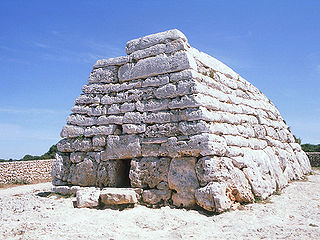
The Naveta d'Es Tudons, or Naveta of Es Tudons, is the most remarkable megalithic chamber tomb in the Balearic island of Menorca, Spain.
A Natural Area of Special Interest is a protected area within the Balearic Islands, Spain that is below the level of a natural park.

The Talaiotic Culture or Talaiotic Period is the name used to describe the society that existed on the Gymnesian Islands during the Iron Age. Its origins date from the end of the second millennium BC, when the inaccurately named Pre-Talaiotic Culture underwent a crisis and evolved into the Talaiotic Culture. Its name is derived from the talaiots, which are the most abundant and emblematic structures from the prehistoric period of the Balearic Islands.

Sa Cudia Cremada is the name of an archaeological site located in a land property called in the same way, in the outskirts of the city of Mahón, the capital of Menorca.

The Menorquina is an endangered breed of cattle from the Mediterranean island of Menorca, in the Spanish autonomous community of the Balearic Islands. It belongs to the group of convex-profiled red cattle, whose distribution across the northern Mediterranean region is thought to have followed the path of the Bell-Beaker Culture. It is one of only two autochthonous Spanish breeds of dairy cattle, the other being the Pasiega. The milk is particularly suitable for cheese production, and is used to make Mahón cheese, which has DOP status.
There are two funerary hypogea in Biniai Nou (Mahón), which were built in the Chalcolithic period. These hypogea have their chamber excavated into the rock, whereas the access or corridor was built with vertical stone slabs, which form a megalithic façade.
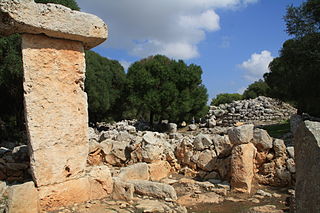
Binissafullet is a Talayotic settlement which was occupied from the 10th century BC and had its height during the 4th and 3rd centuries BC. It is located in Menorca, one of the Balearic Islands. Medieval Islamic materials scattered around the site's surface suggest a later occupation during the Medieval period.
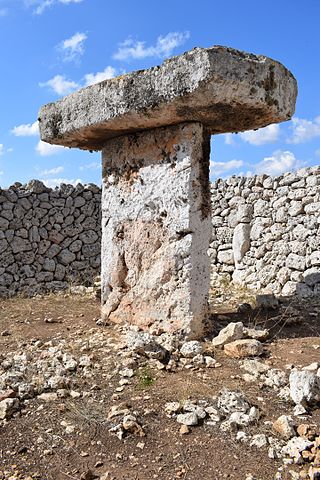
The settlement of Torrellisar is highly altered due to the farming activities that have taken place in the area during the past few centuries since it was abandoned. Despite this, several remains can still be seen, such as its taula monument. The site is located near the road that connects Alayor and Cala en Porter. At km point 5,5 there is the rural road of Cotaina to the right and after 400 meters the site can be found.

The following outline is provided as an overview of and topical guide to Barcelona:

Antigüedades célticas de la isla de Menorca is a book written by the Menorcan scholar Juan Ramis y Ramis (1746–1819). It was published in Mahón in 1818 and is the first book/treatise wholly dedicated to prehistory in Spain.
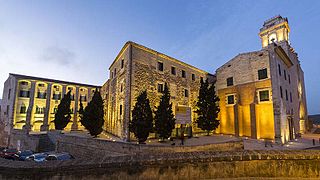
Museo de Menorca is a public institution located in the city of Mahón, Balearic Islands, Spain, which is devoted to the research and diffusion of the prehistory and history of Menorca.


















